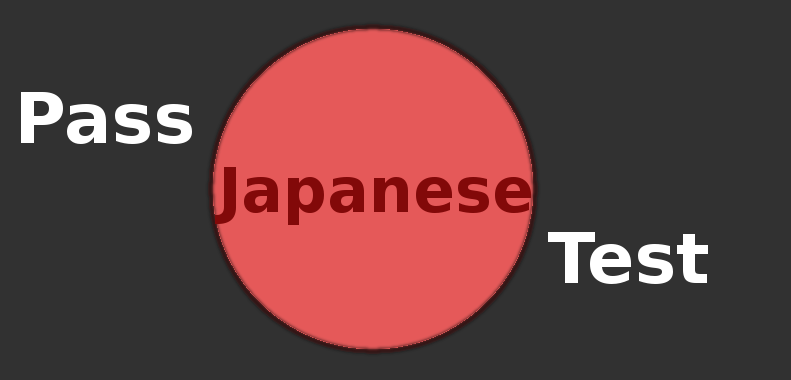In this post, I’ll talk about some JLPT vocabulary strategies that helped me when taking the test. Please see my post on JLPT test sections if you are unfamiliar with the different question types in the vocabulary section. If you are a seasoned SAT veteran, you may recognize some of these strategies or used variations of them on the SAT.
First, let me give some overall pointers to keep in mind during this section.
Overall Strategies
Study Before The Exam
Yes, this sounds obvious. It is. When it comes to vocabulary, the best way to improve your score is by learning more words. The only way to do this is by studying beforehand.
Don’t Waste Time. Guess And Move On.
When it comes to the vocabulary section, you either know the answer or you don’t. If you know the answer, you don’t need to use any strategies to eliminate choices, just bubble in the correct answer.
It is easy to get caught up in one question as you deliberate between two choices. If you find yourself looking at the same question for more than a minute, remember that it is only one question. There are many more on the test that require your attention. Use one of the strategies below to eliminate choices, guess, and move on.
Strategies Per Question Type
1. Kanji Reading
This is where you give the reading for the underlined kanji. Learning kanji readings is basically brute force memorization of the on-yomi and kun-yomi for each character.
Cross off wrong choices by x-ing the incorrect character
I like to think about the readings of the individual kanji characters and cross off choices that do not fit. Instead of simply putting a line through the entire choice, I intentionally put an “x” on the character that has a different reading. This way I know exactly why the choice is incorrect. If I need to deliberate on a question for a few seconds, this saves me from having to re-read and remember why I eliminated a choice.
2. Orthography
(N2-N5 Only)
Orthography is where you select kanji for the underlined hiragana. There are two ways these questions will try to mislead you: by providing multiple choices that have the underlined reading and by providing multiple choices with similar meanings that all fit the question.
I like to approach these questions by doing the following.
Eliminate choices based on kanji reading
This strategy may seem obvious, but at the lower levels the questions usually have only one choice that fits the given reading–at least all the questions I have seen have only one. The N2 might have up to 2 choices that fit the reading.
Eliminate choices based on kanji meaning
Even if you don’t know the readings of the choices, you can still eliminate choices based on the meaning of the kanji. I find it useful to make up an English–insert your native language here–phrase for each choice (this does not have to be the real dictionary meaning of the word; something you make up by thinking about the meanings of the individual kanji is just fine) . This allows me to forget about the reading and focus entirely on the meaning. Does the English phrase fit into the sentence? If it does not, eliminate the choice. I personally find that doing this usually leaves me with 2 choices. If this is true, then I now have a 50/50 chance of guessing the answer correctly.
3. Word Formation
(N2 Only)
This question type asks you to form a 3-5 character kanji word. This is where real world experience with Japanese is important, as the answer is always a well accepted/used compound.
It is culturally Japanese?
One hint when it comes to these questions, and for the JLPT in general, is that the answer must not only make sense linguistically, but usually also culturally. So if the sentence doesn’t sound like something a Japanese person would say or do, then you might need to take another look at the choices.
Trust your instincts
If you are N2 level, then you’ve probably been studying Japanese for a while. You’ve probably used and experienced it in a variety of contexts. Without knowing it, you may have developed a “feeling” about something sounding correct or not. If you have eliminated choices that don’t fit, go with your gut feeling.
4. Contextually Defined Expressions, 5. Paraphrases, 6. Usage
I’m lumping all 3 question types together because the strategy I use when trying to make educated guesses is basically the same.
Positive/Negative
I often use this strategy to help me guess more effectively. It is simple and fairly easy to employ.
Read the question and label the blank/underlined word as positive or negative. Look at each choice and label it as positive or negative. Eliminate choices that don’t match the polarity of the blank/underlined word.
How do you label a word you don’t know the meaning of? One possibility is to look at the kanji. If it has characters such as 悪, 苦, or 反 then it is probably negative. If it has characters such as 良, 豊, or 優 then it is probably positive. This is where having strong knowledge of kanji comes in very handy. Another way of labeling an unknown word the same as 3. Word Formation above. Try making an English phrase from the meanings of the individual kanji. Is the English phrase positive or negative?
Checkout the rest of the JLPT Playbook
